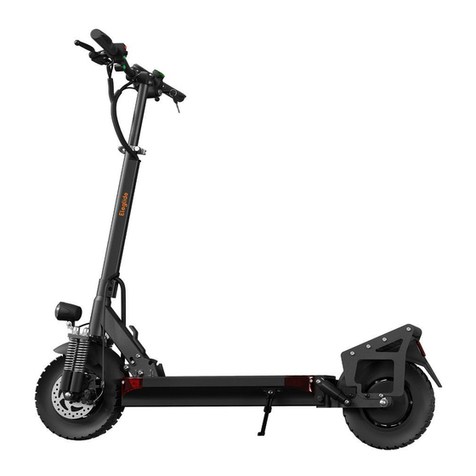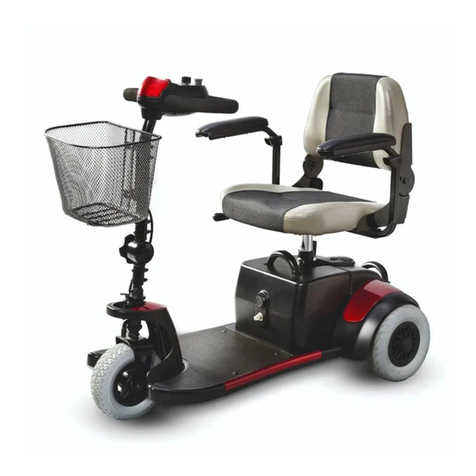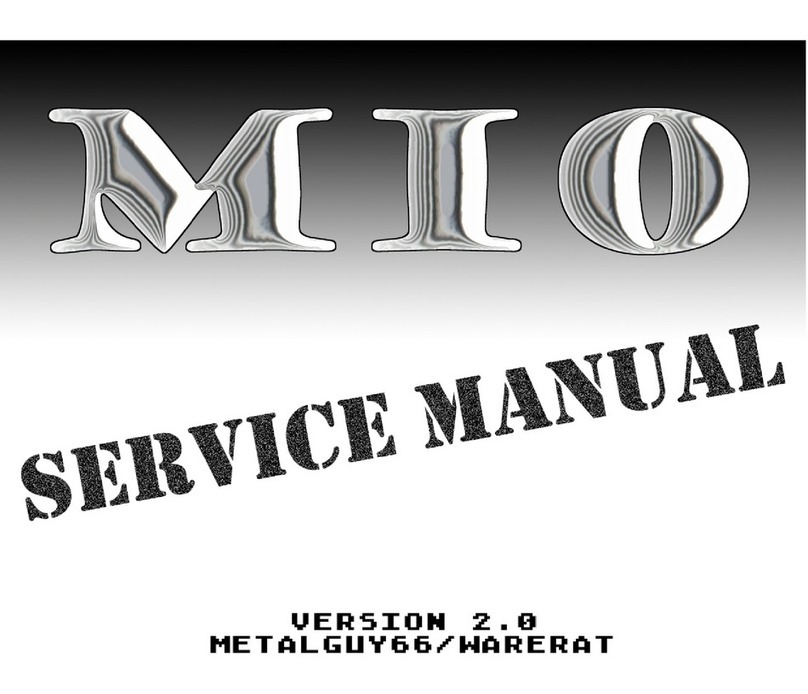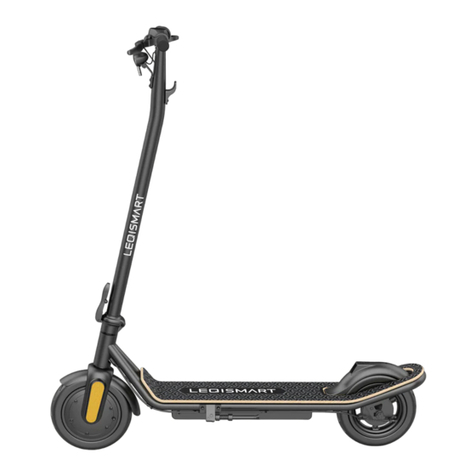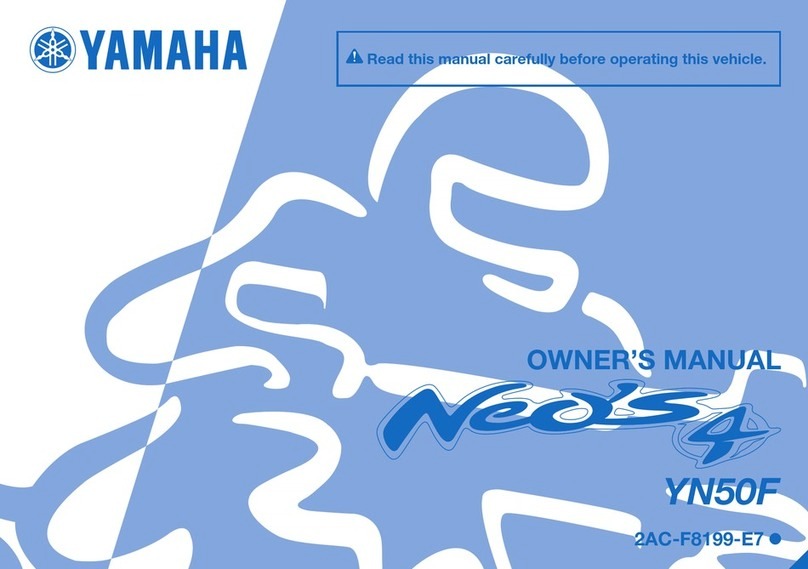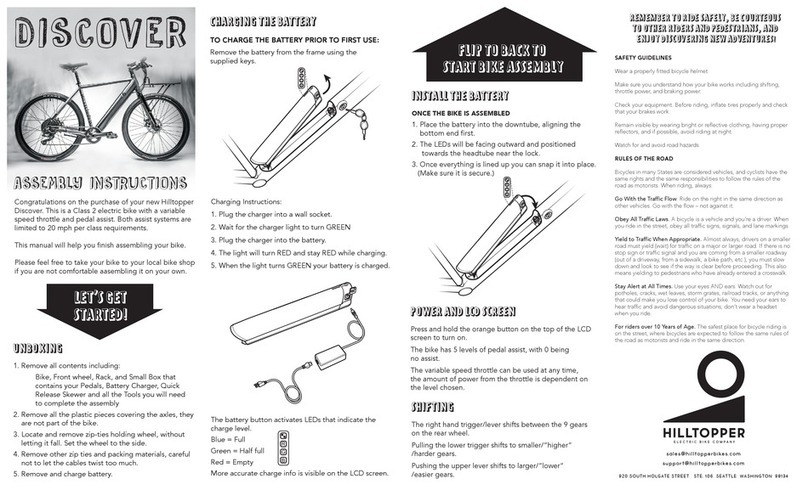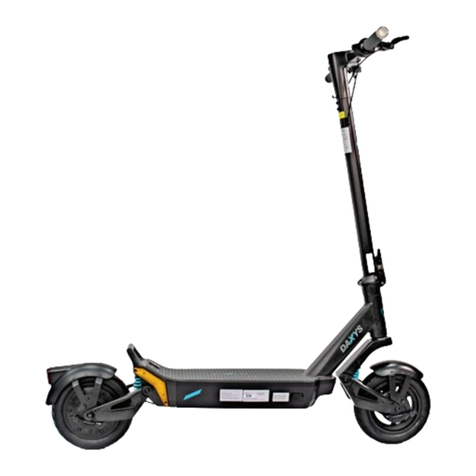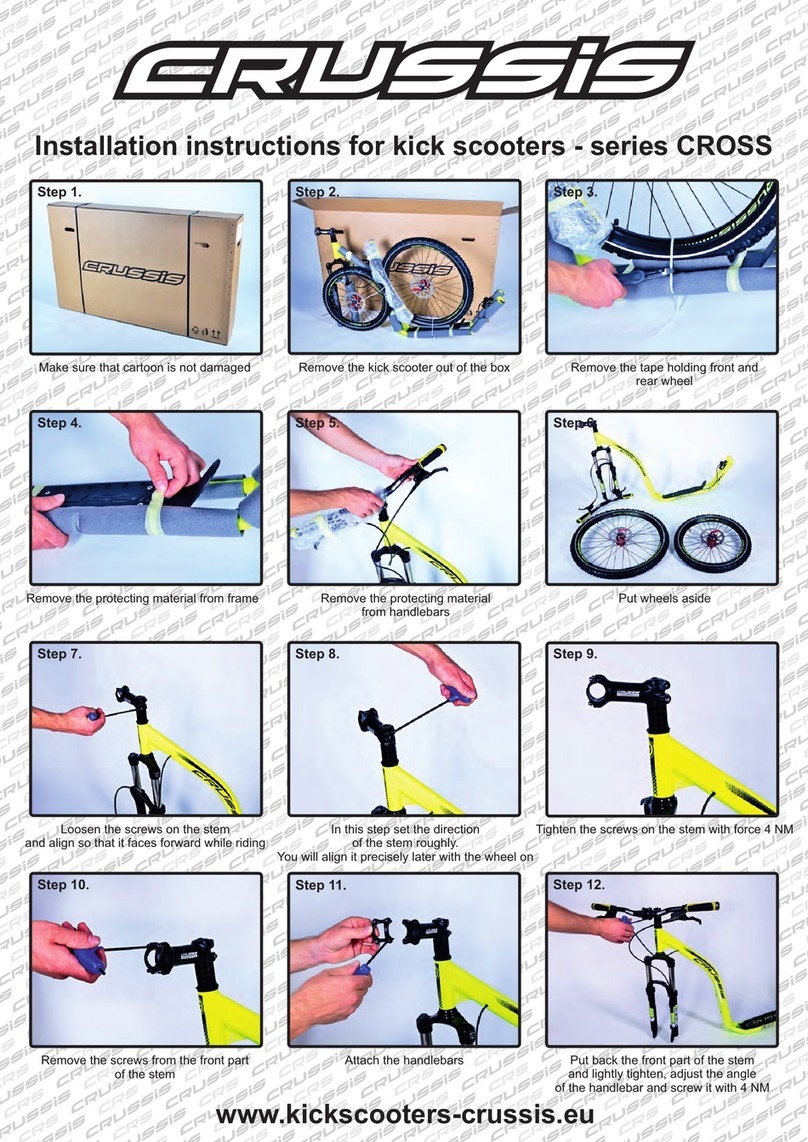Eleglide E-bike M1 User manual

User Manual

ENGLISH ----------------------------------------- 1~13
FRANÇAIS ------------------------------------- 14~26
DEUTSCHE ------------------------------------ 27~39
ITALIANO -------------------------------------- 40~52
ESPAÑOL -------------------------------------- 53~65
SHENZHEN GEEKBUY E-COMMERCE CO., LTD.
Website: http://www.eleglide.com/
E-mail: [email protected]
Address: 19th Floor, Galaxy World Tower B, #1 YaBao Rd.,
LongGang District, Shenzhen, China.
CATALOGUE

Contents
1. Note
2. Diagram
3. Specification
4. Illustration Guide
5. Cleaning
6. Storage
7. Warning
8. Trouble Shooting
9. Warranty
*Before the first operation, please
read the user manual carefully!
ENGLISH
EN
1

1. Note
This manual was written to help you get the most performance, comfort,
enjoyment and safety when riding your new bicycle. It is important for you
to understand your new bike. By reading this manual before you go out on
your first ride, you’ll know how to get the most from your new bicycle. It is
also important that your first ride on your new bicycle is taken in a
controlled environment, away from cars, obstacles, and other cyclists.
The electric bike is supplied without basic mandatory equipment, which
may vary from place to place. Therefore, if you intend using the electric bike
on public roads, it's necessary to equip the bike with the basic mandatory
equipment, in accordance with the relevant laws and regulations.
This product is designed for home use. Do not use it for commercial or
other purposes.
Keep this manual in a safe place to be able to find information in the future
or for other users.
Bicycles are vehicles with certain risks, please make sure to follow the traffic
rules. Also, when emergency braking, apply brakes to the rear wheel first,
and only then the front wheel, especially if the cycling speed is too high. If
the front brake is used suddenly, you may fall over. Please ride carefully.
2. Diagrama
EN
2

Handlebar with control panel
AElectric Motor
EBattery
I
Front wheel
BRear Derailleur
FSpoke
J
Brake
CRear Wheel
GChain
K
Pedals
DSaddle
HFront Derailleur
L
12
3
5
4
3
678
910
1. Left Brake 5. Rear Derailleur shifter 9. Mode Button
2. Right Brake 6. ON/OFF button 10. Mode Indicator
3. Handlebar 7. Light ON/OFF Button
4. Front Derailleur shifter 8. Battery Capacity Indicator
3. Specification
Main technical spec
Max weight: M1 21.6KG; M1 PLUS 21.6KG; F1 21.6KG;
Max Range (Moped Mode):
M1 50KM-65KM; M1 PLUS 85KM-100KM; F1 70-85KM;
Electricity consumption(100KM) 0.72KWH
Loading weight ≤100KG
Battery spec
Battery type: lithium-ion battery
Capacity: M1 7.5AH; M1 PLUS 12.5AH: F1 10.4AH
Voltage 36V
EN
3

Motor spec
Type brushless DC motor
Rated power 250W
Rated speed: 380R/MIN
Max torque: 45N.M
Voltage 36V
Controller spec
Voltage: 36V
Current:16A
Max Handlebar Reach-26.5’’
Min Handlebar Reach-25’’
Handlebar Hgt-40’’
Max Seat Hgt-40’’
Min Seat Hgt-32.5’’
Standover Hgt-29.5’’
Wheelbase-42’’
Total Length-68’’
Size spec
M1
EN
4

Max Handlebar Reach-27’’
Min Handlebar Reach-25.5’’
Handlebar Hgt-41’’
Max Seat Hgt-41’’
Min Seat Hgt-33.5’’
Standover Hgt-30’’
Wheelbase-43.5’’
Total Length-70.5’’
M1PLUS
F1
Max Handlebar Reach-28’’
Min Handlebar Reach-26.5’’
Handlebar Hgt-39.5’’
Max Seat Hgt-40’’
Min Seat Hgt-32.5’’
Standover Hgt-29’’
Wheelbase-44.5’’
Total Length-70.5’’
Packing List
Eleglide E-bike x 1 Pedal x 2 Charger x 1
User Manual x 1 Battery x 1 Saddle x 1
EN
5

4. Illustration Guide
1) Installing the Front Wheel:
A) Take out the bike and make it stand up.
B) Loose the nut, make enough space for the wheel to insert.
C) Insert the wheel between the fork blades so that the axle seats firmly at
the top of the fork dropouts (the slots at the tip of the fork blades). Note:
The lever should be parallel to the fork blade and curved toward the wheel.
D) Fasten the gasket to the front fork and twistthe nut, make sure the nut
is tightened.
E) Put the gasket back and twistthe nut, make sure the nut is tightened.
Note: If the lever cannot be pushed all the way to a position parallel to the
fork blade, return the lever to the OPEN position. Then turn the tension
adjusting nut counterclockwise one-quarter turn, and try tightening the l
ever again.
2) Installing Handlebar:
A) Open the handlebar clip
B) Put and adjust the handlebar in the middle of the lever.
C) Lock the clip.
EN
6

Open Lock Locked
3) Installing Rear Light: Make it be fit position and locked it.
4) Installing Peddle
Pedal Left Right
5) Installing Seat pot
EN
7

6) Installing Battery: Put the battery to the right position and
unlocked the battery before you use it.
7) Finished: The bike is ready for your first ride. Turn on the
battery and the bike, go out with it.
8) Folding Step(Only for the Model F1)
The bike body folds to one side
Open quick-release handle outward
Seat tube to
minimum
Folding completion
diagram
5. Cleaning
EN
8
Open

A) Always keep the electric bicycle and all its components clean and dry.
B) Check tightening of all joints regularly and also check for possibly minor
damage and cracks. Please remove the machine’s shortcomings immediately.
C) Only clean with a damp cloth.
D) Never immerse the bicycle in water and don’t spray it with water from a
hose or a pressure washer.
E) Do not use abrasives or chemicals.
6. Storage
A) REGULAR CONDITION AND LUBRICATION CHECKS
Like all mechanical machines, the bike is subject to wear and
train.
B) LI-ION BATTERY STORAGE
a.Never keep the Li-ion battery discharged for a long time, if the voltage of
the cell drops under allowed limit due to self-discharge, it will lead to its
damage. For maximum durability, store the battery charged up to maximal
capacity up to 50%.
b. Store the accumulators in a dry and dust free room at the ambient
temperature ranging preferable from 0℃to +25℃. The ideal storage
temperature is 5℃.
c.OTHER PARTS
The following general maintenance and lubrication instructions must be for
the electric bike’s correct operation.
Head Sets Remove, clean and lubricate the rims annually and check
for replacement.
Joints Continuously check all nuts, bolts and quick-release
devices for tightness.
Brakes
Lubricate the brake cables slightly with oil on a monthly
basis. Check the adjustment and in time replace the brake
parts (blocks, shoes, pads) if they are worn. The cables
must be replaced if they are damaged/down.
EN
9

Rubbers Check regularly for damage and wear. Keep repressures as
specified on the side.
Wheel hubs
Lubricate the hub bearings on a monthly basis. Check and
adjust the cones, if necessary, to prevent the hubs from
rubbing against the forks.
Pedals Lubricate the bearings and check for tightness.
Cranks
Lubricate the bearings on a monthly basis (unless a
maintenance-free centre bracket is installed on the bike)
and check all centre bracket parts are correctly tightened.
Chain Take it off and clean it every 6 months. The chain must be
clean but not dry.
Rims
Check frequently that the wheels are tight and securely
fastened. The rims should be protected from oils, waxes,
grease and adhesives, etc. Also check that the spokes
aren’t loose or missing. Have them centered by a specialist
garage at least once a season or if the wheels start to roll.
Sprockets Clean regularly as necessary and lightly grease. Keep the
front and rear derailleur running smoothly by adjusting.
Saddle and
Seat-post fastening Check that screws, nuts and quick-release devices are tight.
Stand Clean and lightly grease annually.
Front suspension
Fork (F1) Entrust it to experts.
d.LUBRICATING
When lubricating, make sure the lubricant doesn’t get on the brake discs and
pads. In the case of oil greases in the brake pads, their function may be lost
7. Warning
A) Do not expose the e-bike to direct sunlight or rain for an extended period
of time, and avoid storing it in places with high temperature or corrosive
gas, so as to avoid chemical corrosion and damage to the electronic parts
and painted surfaces, which may lead to operational failure and accident.
EN
10

B) When water enters the bicycle’s electrical parts (control units, motor or
battery), it can cause irreversible damage or even explode the battery!
C) Before each use, check the charger, cable and plug. If you find damage,
do not use the charger.
D) The wet braking distance will always be over a longer distance than dry
braking. Therefore, start braking well in advance for safe stopping.
E) Before riding, check that the headlights are securely fastened in the
correct position, clean and not covered. Damaged reflectors must be
replaced.
F) If the seat post in the seat tube is not pushed in to at least the minimum
insertion, the seat post may break. Check that the seat post is inserted at
least to the minimum insertion mark.
G) Do not wade through the water and avoid getting into puddles, mud,
water, snow or ice. If the bicycle control unit, engine or battery is immersed
in water will lead to irreversible damage of these parts, eventually can
cause the battery explosion.
H) Never charge the battery in an explosive or flammable environment and
near flammable liquids. Do not carry out charging on a slightly flammable
substrate (such as paper, textiles, etc.) when the battery is removed.
I) Never charge a battery which is visible damaged or its filling is leaking.
J) Do not wade through the water and avoid getting into puddles, mud,
water, snow or ice. If the bicycle control unit, engine or battery is immersed
in water will lead to irreversible damage of these parts, eventually can
cause the battery explosion!
K) This vehicle is not a toy. Same as with other vehicles it is possible to lose
control, fall, crash or encounter other dangerous situations. It is your
responsibility to ensure that all riders understand all warnings, cautions,
nstructions and safety precautions, and to ensure that they are able to
safely and responsibly use this product and protect themselves and others
from injury.
8. Trouble Shooting
EN
11

Please check the following issues before sending to designated repair
offices.+
Problem Possible Causes Solutions
Display does not work/
Vehicle can not turn on
a. No power supply for
vehicles.
a. Charge the battery
b. The electric wire is not
plugged in properly
c. Display is damaged
d. Controller burnout or
water damage
Front light does not
work
a. Wire is not plugged in
properlyte
b. It is damaged
a. Plug the wire in
properly.
b. Contact re-seller.
b. Reconnect the electric
wire properly
C & d. Contact the
re-seller for helping to
solve it.
Battery does not charge a. Charger is not plugged in
properly
a. Plug in properly and
charge.
b. Battery if out/below of
temperature site.
b. Make sure it is the
resume Charging
temperature.
c. Contact re-seller.
Insufficient Range a. Battery is not in full
charge.
a. Charge the battery
fully.
b. Tyre pressure is low
c. Frequent braking
d. Battery aging or
attenuation
b. Check the pressure
before every use.
c. Develop good drive
habits.
d. It’s normal.
Motor does not work a. Brake lever does not back
properly
a. Readjust brake lever
b. The electric wire is not
plugged in properly
c. Sensor / controller is
inefficient
b. Plug the electric wire
in properly.
b. Contact for help.
c. Battery is under rated
voltage
d. Low ambient
temperature, battery
capacity attenuation.
EN
12

Attention: If any other failures occurred and you can not find any solution
above, please contact the re-seller to solve it. And if you need to which need
professional tools, in order to avoid danger, the machine must be repaired
or replaced by manufacturer, other maintenance offices or professionals
from similar offices.
9. Warranty
This product enjoys one year warranty for the machine and 6 months
warranty for the battery service starting from the date of purchase.
A) Inappropriate product selection and the fact that the product does not
meet your requirement can not be a reason for complaint. Buyers is
familiar with the properties of the product.
B) Buyer has the right to ask the sellers to check the functionality of the
product and become familiar with its operation.
C) A prerequisite for receiving warranty claims is that the guidelines for
operating, servicing, cleaning, storage and maintenance were followed.
D) Damage caused by natural wear and tear, overloading, improper use or
intervention outside the authorized service during the warranty period, are
excluded from the guarantee.
Excluded from the guarantee is normal wear, commercial use, alterations to
the appliance as purchased, cleaning activities, consequences of improper
use or damage by the purchaser or a third person, damage, that can be
attributed to external circumstances or caused by the batteries.
E) Warranty does not cover wear and tear of components known as
common consumables (e.g., Bearings, carbon brushes, commutators,
chains, tires, wheel tubes.)
F) From the warranty are excluded wear and tear of the product or parts
caused by normal use of the product or parts of the product (e.g., low
battery or reduce battery capacity after a period of usual life of 6 months)
and other parts subject to natural wear and tear.
G) Damage resulting from defects in material or manufacturer error will be
eliminated free of charge by replacement delivery or repair.
H) Maintenance, inspection and alignment tools are not the warranty act.
EN
13

*Avant la première utilisation, veuillez lire
attentivement le manuel d'utilisation !
Sommaire
1.Note
2.Présentation
3.Spécification
4.Guide de montage
5.Nettoyage
6.Entretien Général
7.Avertissement
8.Résolution de problèmes
9.Garantie
FRANÇAIS
FR
14

1. Note
Ce manuel a été rédigé pour vous aider à obtenir le maximum de
performances, de confort, de plaisir et de sécurité lorsque vous utilisez
votre nouveau vélo. Il est important que vous compreniez le
fonctionnement de votre nouveau vélo. En lisant ce manuel avant votre
première sortie, vous saurez comment tirer le meilleur parti de votre
nouveau vélo. Il est également important que votre première sortie sur
votre nouveau vélo se fasse dans un environnement contrôlé, à l'écart des
voitures, des obstacles et des autres cyclistes.Les vélos sont des véhicules
présentant certains risques, veillez à respecter le code de la route. De plus,
lors d'un freinage d'urgence, freinez d'abord avec la roue arrière, et
seulement ensuite la roue avant, surtout si la vitesse du vélo est trop
élevée. Si le frein avant est utilisé brusquement, vous risquez de tomber.
Veuillez rouler prudemment.Le vélo à assistance électrique est fourni sans
équipement de base obligatoire, qui peut varier d'un endroit à l'autre. Par
conséquent, si vous avez l'intention d'utiliser le vélo électrique sur les
routes publiques, il est nécessaire d'équiper le vélo avec l'équipement de
base obligatoire, conformément aux lois et règlements en vigueur.Ce
produit est conçu pour un usage domestique. Ne l'utilisez pas à des fins
commerciales ou autres.Conservez ce manuel dans un endroit sûr pour
pouvoir trouver des informations à l'avenir ou pour d'autres utilisateurs.
2. Présentation
FR
15

Guidon avec panneau
de commande
AMoteur électrique
EBatterie
I
Roue avant
BDérailleur arrière
FRayon
J
Frein
CRoue arrière
GChaine
K
Pédales
DSelle
HDérailleur avant
L
12
3
5
4
3
678
910
1. Frein Gauche 5. Dérailleur arrière 9. Sélection du mode
2. Frein droit 6. Interrupteur
MARCHE/ARRET
10. Voyant Indicateur
du mode sélectionné
3. Guidon 7. Interrupteur Lumière
MARCHE/ARRET
4. Dérailleur avant 8. Indicateur de batterie
restante
3. Spécification
Principales caractéristiques techniques
Poids maximum: M1 21.6KG; M1 PLUS 21.6KG; F1 21.6KG;
Autonomie maximale (mode cyclomoteur) :
M1 50KM-65KM; M1 PLUS 85KM-100KM; F1 70-85KM;
Consommation électrique (100KM) 0.72KWH
Poids supporté ≤100KG
Spécifications de la batterie
Type de batterie : lithium-ion
Capacité: M1 7.5AH; M1 PLUS 12.5AH: F1 10.4AH
Tension 36V
FR
16

Spécification du moteur
Type moteur brushless DC
Puissance nominale 250W
Vitesse nominale: 380R/MIN
Couple max: 45N.M
Tension 36V
Spécifications du contrôleur
Tension: 36V
Courant :16A
Packing List
Vélo à assistance
électrique Eleglide x 1 Pédale x 2 Chargeur x 1
Manuel d’utilisation x 1 Batterie x 1 Selle x 1
4. Guide de montage
1) Installation d'une roue avant à attache rapide:
A) Dépliez le vélo et mettez-le en position debout.
B) Desserrez l’écrou, retirez l’écrou et le ressort de serrage rapide.
C) Tournez l’attache de blocage rapide en position OUVERT.
D) Insérez l’attache de blocage entre les lames de la fourche de manière à
ce que l'axe s'appuie fermement sur le haut des pattes de la fourche (les
fentes à l'extrémité de la fourche).
E) Remettez le ressort en place et serrez l'écrou, assurez-vous que l'écrou est
bien serré.
FR
17

Note: Si le levier ne peut pas être poussé à fond jusqu'à une position
parallèle à la lame de la fourche, remettez le levier en position OPEN.
Tournez ensuite l'écrou de réglage de la tension d'un quart de tour dans le
sens inverse des aiguilles d'une montre, puis essayez de resserrer le levier.
2) Installation du guidon :
A) Ouvrez le clip du guidon
B) Placez et ajustez le guidon au milieu du levier.
C) Verrouillez le clip
Ouvrir Positionné Verrouillé
3) Installation du feu arrière: Assurez-vous qu'il
soit en bonne position et verrouillé.
FR
18
Other manuals for E-bike M1
1
This manual suits for next models
2
Table of contents
Languages:
Other Eleglide Scooter manuals
